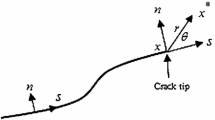Abstract
A solution procedure for elastic contact fracture mechanics has been proposed in this paper. The procedure is based on the quadratic programming and finite element method (FEM). In this paper, parametric quadratic programming method for two-dimensional contact mechanics analysis is applied to the crack problems involving the crack surfaces in frictional contact. Based on a linear complementary contact condition, the parametric variational principle and FEM, a linear complementary method is extended to analyze contact fracture mechanics. The near-tip fields are properly modeled in the analysis using special crack tip elements with quarter-point nodes. Stress intensity factor solutions are presented for some frictional contact fracture problems and are compared with known results where available.
Similar content being viewed by others
References
Barsoum, R.S. (1976). On the use of isoparametric finites in linear fracture mechanics. International Journal of Numerical Methods in Engineering 10(1), 25–37.
Beghini, M. and Bertini, L. (1996). Effective stress intensity factor and contact stress for a partially closed Griffith crack in bending. Engineering Fracture Mechanics 54, 667–678.
Bowie, O.L. and Freese, C.E. (1976). On the ‘overlapping’ problem in crack analysis. Engineering Fracture Mechanics 8, 373–379.
Chan, S.K. and Tuba, I.S. (1971). A finite element method for contact problems of solid bodies. International Journal of Mechanical Sciences 13, 615–639.
Comminu, M. and Dundurs, J. (1979). On frictional contact in crack analysis. Engineering Fracture Mechanics 12, 117–123.
Cordes, R.D. and Joseeph, P.F. (1994). Crack surface contact and internal cracks in a plate with residual stresses. International Journal of Fracture 66, 1–17.
Fredriksson, B. (1976). Finite element solution of surface non-linearities in structural mechanics with special emphasis to contact and fracture mechanics problems. Computer & Structures 6, 281–290.
Klarbring, A. (1986). A mathematical programming approach to three-dimensional contact problems with friction. Computer Methods in Applied Mechanics and Engineering 58, 175–200.
Lemke, C.E. (1965). Bimatrix game equilibrium points and mathematical programming. Management Science 11, 681–689.
Leung, A.Y.T., Chen, G.Q. and Chen, W.J. (1998). Smoothing Newton method for solving two-and threedimensional frictional contact problems. International Journal for Numerical Methods in Engineering 41(6), 1001–1027.
Liu, S.B. and Tan, C.L. (1992). Two-dimensional boundary element contact mechanics analysis of angled crack problems. Engineering Fracture Mechanics 42(2), 273–288.
Melville, P.H. (1977). Fracture mechanics of brittle materials in compression. International Journal of Fracture 13, R532–R534.
Murakami, Y. (1987). Stress intensity factors handbook. Oxford, Pergaman.
Okamoto, N. and Nakazawa, M. (1979). Finite element incremental contact analysis with various frictional conditions. International Journal For Numerical Methods in Engineering 14, 337–357.
Owen, D.R.J. and Fawkes, A.J. (1983). Engineering Fracture Mechanics: Numerical Methods And Applications. Pineridge Press Limited, Swansea, U.K.
Reklaitis, G.V., Ravindran, A., Mragsdell, K. (1983). Engineering optimization, Method & Application. John Wiley and Sons, NY.
Thiagarajan, S. and Alwar, R.S. (1986). Influence of crack closure in the case of an angled crack. Engineering Fracture Mechanics 24, 533–537.
Tsung-Chieh Chen and Wen-Hwa Chen (1998). Frictional contact analysis of multiple cracks by incremental displacement and resultant traction boundary integral equations. Engineering Analysis with Boundary Elements 21, 339–348.
Woo, C.W., Cheung, Y.K., Chen, Y.Z. and Wang, Y.H. (1988). A simple model for the contact problem of a finite cracked plate in bending. Engineering Fracture Mechanics 29, 227–231.
Zhong, W.X. and Sun, S.M. (1989). A parametric quadratic programming approach to elastic contact problems with friction. Computer & Structure 32(1), 37–43.
Zhong, W.X. and Zhang, H.W.(1997). Parametric variational principles and its application in engineering. Science Press, Beijing (in Chinese).
Author information
Authors and Affiliations
Rights and permissions
About this article
Cite this article
Su, R., Zhu, Y. & Leung, A. Parametric quadratic programming method for elastic contact fracture analysis. International Journal of Fracture 117, 143–157 (2002). https://doi.org/10.1023/A:1020925903552
Issue Date:
DOI: https://doi.org/10.1023/A:1020925903552




